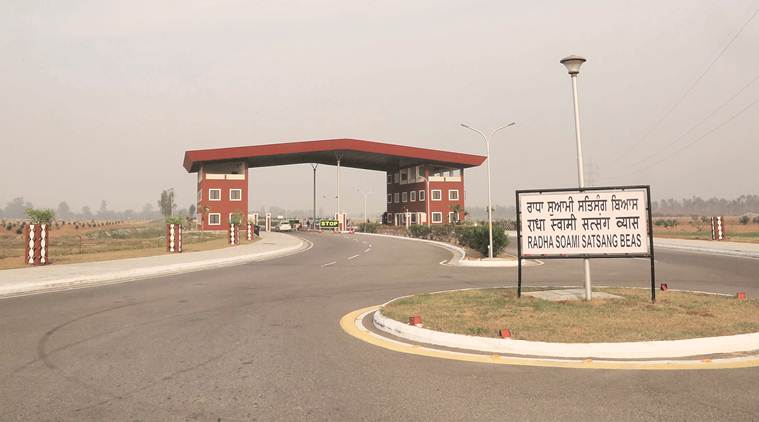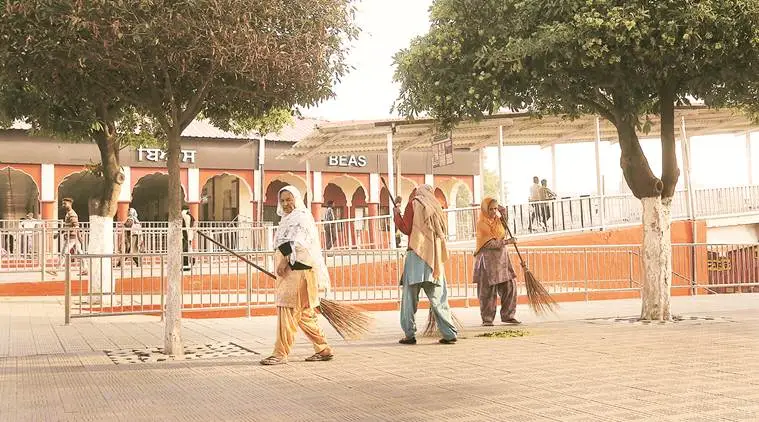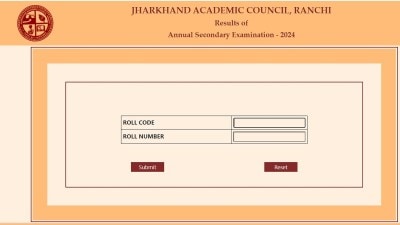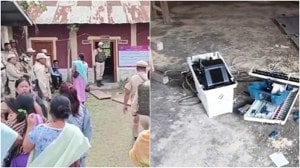- India
- International
The dera by the Beas
The third figure in the Ranbaxy brothers’ corporate battle is Gurinder Singh Dhillon, the head of Radha Soami Satsang Beas — among the largest such communes in the world, with 20 mn followers in 90 countries, yet fiercely secretive. The Indian Express on the man and his sect
 The dera is run by the Radha Soami Satsang Beas (RSSB) Trust, a non-profit society headed by a secretary with the dera chief as its patron.
The dera is run by the Radha Soami Satsang Beas (RSSB) Trust, a non-profit society headed by a secretary with the dera chief as its patron.
Somewhere between Jalandhar and Amritsar on the Grand Trunk Road, a long, winding path breaks off and stops at an imposing gate, one of half-a-dozen entrances to the headquarters of Dera Baba Jaimal Singh, known more commonly as Radha Soami Satsang Beas, a sprawling commune on the banks of the Beas river.
Much like its 65-year-old head Gurinder Singh Dhillon, “Babaji” or “Master” to 20 million followers across 90 countries, the dera is fiercely private. Devotees guarding the gates tell you to deposit bags, mobiles, and cameras before venturing in. The rationale, the volunteers often say, is that “you leave the material world outside as you journey to your inner self”.
But, for some time now, the outside world has been threatening to intrude into this closed universe, with Babaji, the presiding deity of the town, and his family thrust into the ugly legal battle between Malvinder Mohan Singh and Shivinder Mohan Singh, former promoters of Ranbaxy. All the dramatis personae in the case are related to the dera — former dera head Charan Singh is the maternal grandfather of the Singh brothers, while Dhillon, whom he eventually chose as his heir, is Charan Singh’s sister’s son.
 Dhillon, on the right in the photograph, is the fifth dera chief. (Express Photo: Jaipal Singh )
Dhillon, on the right in the photograph, is the fifth dera chief. (Express Photo: Jaipal Singh )
It all began with Japanese drug maker Daiichi Sankyo,which had bought the Singh brothers’ 34.82% stake in Ranbaxy in 2008 for $2.4 billion, filing a case in the Delhi High Court in 2018. It alleged that the Singhs had siphoned off over Rs 2,000 crore from their companies through loans to Shimal Healthcare and Prius Real Estate. Dhillon’s wife Shabnam was earlier listed as a director with Prius. But Prius told the judge that the firm was neither owned by the Singhs, nor was it a downstream company of theirs.
Nearly four months later, elder Singh brother Malvinder wrote to the Economic Offences Wing, accusing the dera spiritual head of working in “collusion and connivance” with Shivinder to cause “wrongful loss” to him and the shareholders of RHC Holding Pvt Ltd, a firm he once jointly owned with his younger brother.

Malvinder also alleged that the dera chief was “threatening” him to sign a settlement, freeing the Dhillons of any financial liability. His affidavit in the Supreme Court this year also claims that over Rs 6,000 crore in loans and advances are to be recovered from “various” individuals and companies, including Prius and the dera chief himself.
Dhillon had taken over as the fifth chief of the Beas dera in 1990, after the death of Charan Singh, a lawyer who had headed the dera since 1951. It’s said that Dhillon was home from Spain, where he worked, for the birth of his second son when Charan Singh passed away and he learnt of his anointment as dera chief.
The elderly gatekeepers on volunteer duty at the dera’s newest three-storey outpost still remember the day Dhillon became dera chief. “Babaji was a young man, all of 36, with a trimmed black beard,” recounts Mahender Singh, who owns a cloth shop in Kaithal and joined the dera in 1984.
A R Rajwade, a retired mathematics professor who lives next door to the Dhillon family mansion in Sector 8, Chandigarh, recounts seeing Dhillon as a young man on his bike. “His father Gurmukh Singh, an affluent landlord from Moga, built this house.”
Dhillon’s mother Mohinder Kaur continues to live in the house after his father passed away in the Nineties. Dhillon’s wife Shabnam, 58, who used to divide her time between the dera and the homes of her sons Gurpreet and Gurkeerat Singh, in Singapore and London, respectively, passed away on November 27 following complications after an abdominal surgery in London. She was cremated at the dera.
Dhillon’s friends, who call him “Moga”, also recall his love for bike drives, and Beatles and Paul Anka. “He studied at Sanawar while I was at Bishop Cotton School in Shimla. We became friends when he joined B.Com at Panjab University,’’ says retired Punjab and Haryana High Court Justice S S Saron.
 One of the many gates leading to the dera; volunteers at the Beas railway station (Express Photo: Jaipal Singh)
One of the many gates leading to the dera; volunteers at the Beas railway station (Express Photo: Jaipal Singh)
Under Dhillon’s 29-year tenure, the dera has grown in strength and now has over 5,167 satsang centres across the country and over 500 abroad. The dera headquarters at Beas in Amritsar district is a self-contained ‘city’, with an air strip, a CBSE-affiliated school, apartments, an industrial area, a shopping mall, and a network of underpasses for the smooth flow of traffic.
The dera is run by the Radha Soami Satsang Beas (RSSB) Trust, a non-profit society headed by a secretary with the dera chief as its patron.
On any given day, 15,000-20,000 come for daily satsang at the dera, with the number rising to several lakhs when the dera chief is addressing it. This summer, the dera hosted five lakh people for a satsang with Dhillon. Besides 15 sheds that can house 8,000 to 12,000 people each, there are dorms, serais or guest houses and apartments for visitors. The biggest of the satsang halls is spread over 80 acres and can accommodate five lakh people. The parking area within the campus can hold 50,000 vehicles.
The dera also boasts one of the world’s largest single rooftop solar facilities. Inside the township is an industrial area where the sewadars make everything, from paver blocks and tiles to furniture and grilles. “There is nothing we get from outside,” says J S Sethi, a retired chief engineer and secretary of the Trust since 2005.
Like with deras elsewhere in the state, the Radha Saomi sect depends heavily on volunteers or jathas to keep the giant dera machinery running. The volunteers are spread across the dera — men and women, who come in as per a pre-determined schedule every day.
The Beas railway station has been taken over this Tuesday evening by dera volunteers who have come to receive a jatha from Hoshiarpur. A batch of volunteers sweeps the station while waiting.
Soon, the jatha arrives and its members head to the two buses in the parking area. “We come here from Hoshiarpur on the 19th of every month. This month, we have been assigned the dera’s sanitation department,’’ says Satnam Singh, a farmer.
With the rapid expansion of the dera have come attendant controversies, the case of alleged fund diversion involving the Singh brothers only the latest.
In 2016, when the Akali-BJP government was in power in the state, former Patiala AAP MP Dharamvir Gandhi took a round of five adjoining villages and claimed that he had come across marginal framers who had been allegedly forced to sell their land to the dera at throwaway rates.
“I got to know that the dera administration is acquiring land through deceit and in connivance of local revenue officials,” says Gandhi, who raised the issue in Parliament.
Though a probe was initiated, nothing came of it. Dismissing Gandhi’s allegations, Sethi says the dera pays compensation at the rate of Rs 2.5 lakh a marla against the market rate in these parts of Rs 40,000 a marla.
Dhillon himself has rarely commented on any controversy, adding to his reluctant godman image.
“He hates being photographed,” says a former follower, who claims to have left the dera because he found it “too austere”.
This month though, Dhillon finally broke his silence on the Ranbaxy allegations, denying RHC’s claims of “huge receivables” from him and his family. Instead, he accused the Singh brothers of owing him over Rs 70 crore that he had loaned to them in 2011.
Mention the case to Sethi of the RSSB Trust and he bristles. “The RSSB has not taken a single paisa from the Singh brothers, you can check our records. Neither the dera nor Babaji like giving clarifications. We believe that ultimately the truth will come out.’’
Apr 19: Latest News
- 01
- 02
- 03
- 04
- 05






































